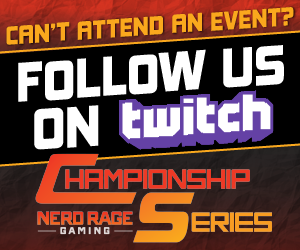Why We Love Legacy: Mat Bimonte on Lands
Over the past 2 years I have played a ton of competitive Magic. Most of that time has been spent brewing and playing Standard decks, learning and playing the Modern format, and trying to figure out how to take my play to the next level.
I have played a ton of competitive Magic. Most of that time has been spent brewing and playing Standard decks, learning and playing the Modern format, and trying to figure out how to take my play to the next level.
Most of you probably remember me having a pretty unhealthy disdain for Legacy as I hated the combo decks, I hated Sensei’s Divining Top (R.I.P.), and I hated that Brainstorm fixed all of your mistakes you decided to make.
When the NRG Series adopted quite a few Legacy tournaments to their schedule, I knew I needed to stomach it and play the format a bunch if I was wanting to qualify for the Championship.
Within that testing I found a new love for the format, and found my partner for the dance: Lands.
This decklist has been popularized by Jody Keith:

With all of his success, who am I to question his choices? So rather than bore you with card choices I don’t have thousands of game testing to back up, I’m going to walk you through my learning experience, and hopefully minimize the early growing pains of playing this deck for you.
One of the biggest hurdles to conquer while playing Lands is learning that it’s a combo second deck. In reality this is the best prison deck in the format since Miracles has all but left. Legacy is a format notorious for low land counts and, further, low basic land counts. Having access to eight Wastelands is pretty ridiculous, and ultimately your early game plan.
You are able to Punishing Fire or Molten Vortex your opponent’s creatures down, while denying their mana and stopping them from furthering their board. Lands is a very frustrating deck to play against, so put yourself in your opponent’s shoes and make the play that would frustrate you most if you were in their seat.
I always harp on how important it is to do your homework, and that is no different with Lands. You want to have a general idea of how many basic lands your opponents are playing, so you know if the Ghost Quarter + Wasteland + Tabernacle at Pendrell Vale plan is a reliable route to victory.
The next biggest hurdle is understanding how to sideboard, which is almost always the next step in furthering your development with any deck. I’m not going to lie to you: This deck is very hard to sideboard with, as your main engine shouldn’t really be tinkered with too often. Often in decks like these, less is more. Sideboarding should be minimal more often than not.
My go-to is taking out the Manabond, and then looking at the lands that don’t do much in the matchup. Karakas and Bojuka Bog are typically the first cuts, and then you can trim on other cards. Obviously cards such as Punishing Fire are nearly worthless against Storm, so knowing and understanding your opponent’s deck is vital to your overall strategy.
Tips and Tricks:
In my short time playing Lands I have been able to find a few lines that seem important to know.
- Crop Rotation is a
 seriously messed-up card when you have so many things to go and get. One of my favorites for now is being able to Rotation for the one-of Ancient Tomb in your deck to “surprise combo” your opponents by gaining access to an additional mana for Thespian’s Stage.
seriously messed-up card when you have so many things to go and get. One of my favorites for now is being able to Rotation for the one-of Ancient Tomb in your deck to “surprise combo” your opponents by gaining access to an additional mana for Thespian’s Stage. - You can also cast Crop Rotation on turn one against decks like Storm and Reanimator for that same Ancient Tomb in order to cast important cards like Sphere of Resistance and Thorn of Amethyst. I have also rotated in response to a removal spell being cast on Tireless Tracker in order to save it. Talk about a blow out.
- Another well-known play is not Loaming against possible Surgical Extraction decks unless you have either Sheltered Thicket or Tranquil Thicket to cycle in response. I have also Bojuka Bog’d myself with Crop Rotation in order to protect my Loams. While it certainly isn’t the most optimal thing in the world, Loam is arguably your most important card, so you want to protect it at all costs.
- Remember with Manabond that you don’t have to put all of your lands in play. Sometimes you will want to hold additional lands in order to Gamble for certain cards and make your percentage better for holding on to them.
- Copying your own Glacial Chasm with Thespian’s Stage is an old classic many Lands players demonstrate often, but I won’t omit it even though it’s been chronicled before. That is quite the lock against decks like Elves and other creature based decks.
Wrap up
The last thing I want to talk about is the white splash I have seen a few people chat about playing. Adding cards like Solemnity is a mistake, but I did enjoy having cards in the sideboard like Lingering Souls for decks that are overloading hate against you. They might even be better than the Tireless Trackers overall, but I need to do a bunch of sideboarded games to test them further.
Lands is a really sweet deck because you have a ton of options within the game. It is also one of the better decks in the format because it can be customized even with its hard to attack main board plan. The Karakas and Bojuka Bog are interchangeable, the Ghost Quarters can become Rishadan Ports if you expect a lot of basic lands at your tournament. You can play Crucible of Worlds and Ramunap Excavator if you plan on seeing a bunch of Wasteland effects.
I certainly recommend this deck if you expect to see a lot of Delver of Secrets variants, but I can’t express enough how comfortable you need to be with your cards before the tournament begins. You have a bunch of tutor effects in Gamble and Crop Rotation, so knowing your deck, and what you need, when you need it, is a skill you can only acquire after playing a bunch of games. If you enjoy land destruction and making no friends at a tournament, give this a spin at your next Legacy event!
Thanks for stopping by,
Mat Bimonte
Mat Bimonte first picked up the game during Theros block, but already has a Modern 5K championship under his belt, as well as a number of smaller Standard tournament wins. Based out of Bloomington, Ill., Mat is a regular on the SCG Tour, with future aspirations of qualifying for the Pro Tour.



